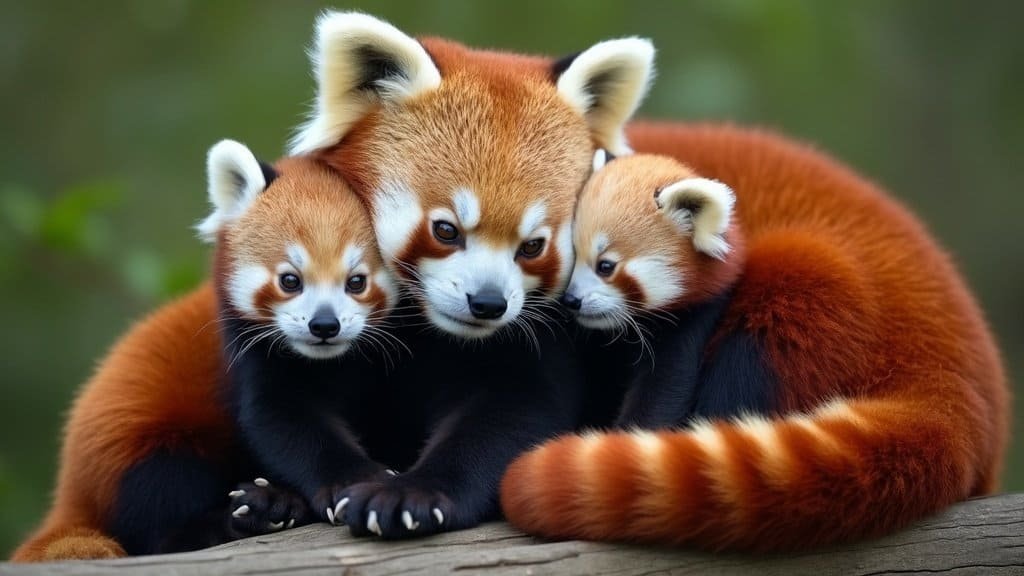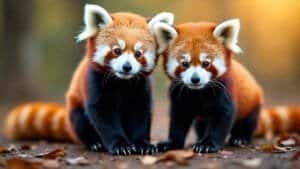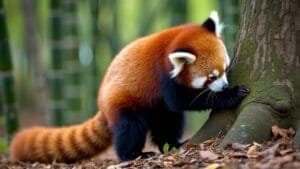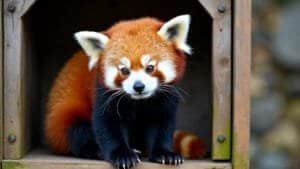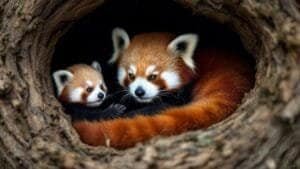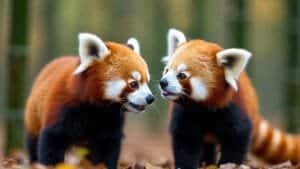Red pandas typically give birth to one to four cubs per litter, with two being the most common. Cubs are born blind and covered in thick fur, weighing only 3 to 5 ounces. Because newborns are completely dependent on their mother, red panda mothers provide intensive care, including nursing, grooming, and maintaining a warm nest inside tree hollows or rock crevices
The survival of red panda cubs depends on litter size, food availability, and maternal health. Smaller litters often have higher survival rates, as each cub receives more maternal attention and nourishment. When larger litters occur, weaker cubs may face competition for milk, reducing their chances of survival
Due to habitat loss and climate change, red panda reproduction is increasingly threatened in the wild. Conservation programs focus on habitat restoration, captive breeding, and genetic diversity management to improve cub survival rates and population stability
This article explores red panda litter size, how mothers care for their young, and the conservation efforts protecting red panda cubs in both the wild and captivity
Litter Size and Reproductive Patterns in Red Pandas
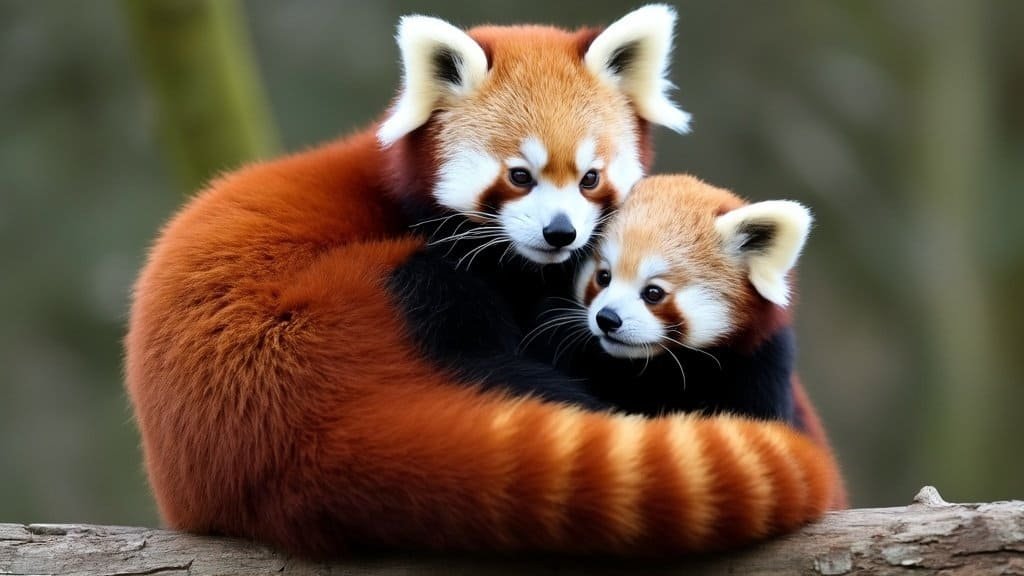
Red pandas have a unique reproductive strategy that allows them to adapt to seasonal food availability and environmental conditions. Unlike species that produce large litters to ensure survival, red pandas give birth to smaller broods, typically ranging from one to four cubs, with two being the most common. This litter size balances maternal care, resource availability, and cub survival rates, ensuring that each newborn has a better chance of reaching maturity (Cape May County)
Because red panda cubs are born blind, helpless, and entirely dependent on their mother, maternal investment is highly demanding. The number of cubs born directly influences maternal workload, food requirements, and overall reproductive success. Understanding how litter size varies and what factors influence it provides insight into red panda population dynamics and conservation needs
What Is the Average Litter Size of a Red Panda?
Red pandas generally give birth to one to four cubs per litter, though two is the most commonly observed number. The average litter size depends on the mother’s age, health, and environmental conditions, as well as food availability during pregnancy and lactation. Larger litters of three or four cubs are rare, as they require significant maternal energy and higher food consumption to sustain all offspring (Toronto Zoo)
Each newborn cub is tiny, weighing only 3 to 5 ounces, and remains completely reliant on maternal care for the first few months of life. Because of their vulnerability, red panda mothers typically focus on raising fewer cubs per pregnancy, increasing each individual’s survival chances. In zoological settings, where food supply and veterinary care are stable, litter sizes may occasionally be larger, but in the wild, two-cub litters remain the norm (National Zoo)
How Do Environmental Conditions Affect Litter Size?
Environmental factors play a major role in determining red panda litter size, as they directly impact maternal health, food supply, and den availability. In years when bamboo forests are abundant, red pandas have a higher chance of successfully carrying and raising multiple cubs. Conversely, during periods of food scarcity, a mother may experience reproductive stress, leading to smaller litters or cub mortality
Delayed implantation, a unique reproductive adaptation in red pandas, also allows females to adjust pregnancy timing based on external conditions. If food availability is low, the mother’s body may delay embryo development, reducing the number of cubs carried to term. This mechanism ensures that cubs are only born when conditions are optimal, preventing weakened litters that struggle to survive in poor environments (Cape May County)
Climate change is another major threat to red panda reproduction, as shifting temperatures disrupt bamboo growth cycles, reducing the food supply needed to sustain pregnancy and lactation. Conservationists have observed that wild red pandas in degraded habitats tend to have smaller litters, as nutritional stress leads to lower reproductive success (National Zoo)
Why Do Some Red Pandas Give Birth to Only One Cub?
While two-cub litters are the most common, some red pandas give birth to only one cub per pregnancy, particularly if they are young, first-time mothers or living in stressed environments. First-time breeders may have smaller litters due to incomplete physiological development, meaning their bodies are less capable of sustaining multiple embryos
Environmental stressors such as deforestation, extreme weather, or food shortages also contribute to single-cub births, as the mother’s body prioritizes her own survival over carrying multiple offspring. In extreme cases, if a red panda mother does not have enough energy reserves, she may reabsorb embryos before birth, preventing a pregnancy from continuing to full term (Toronto Zoo)
Single-cub births are more common in wild populations, where reproductive success is more dependent on habitat quality and food availability. In captivity, where nutrition, veterinary care, and environmental stability are ensured, red pandas are more likely to successfully carry and raise multiple cubs. Understanding why some red pandas have smaller litters helps conservationists develop better management strategies for wild and captive populations
For more insights into red panda litter sizes and maternal care, visit the National Zoo’s article on red panda cub development
Maternal Care and Survival Challenges for Red Panda Cubs
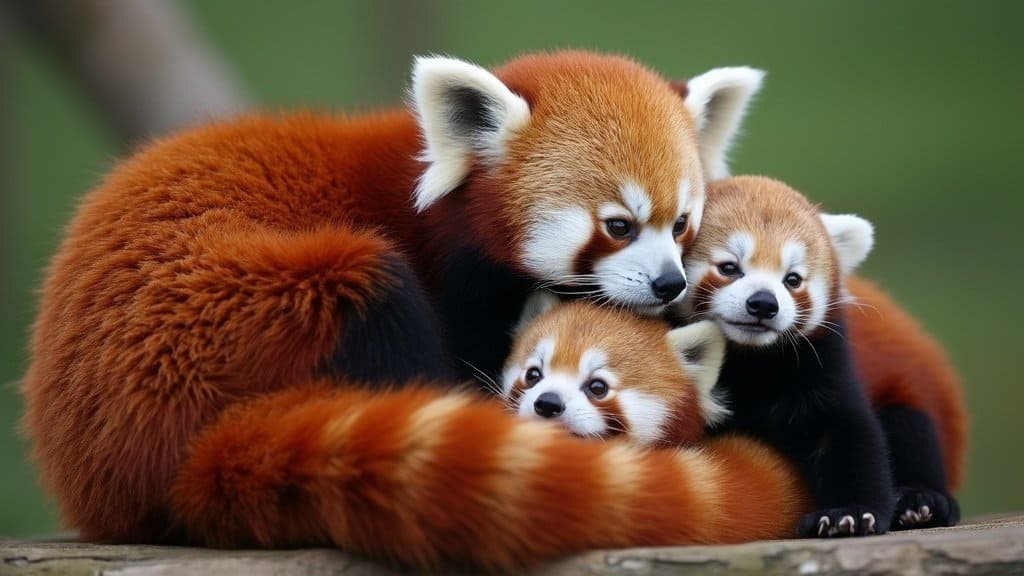
Red panda mothers play a critical role in ensuring the survival of their cubs, as newborns are born blind, immobile, and completely dependent on maternal care. Unlike species that rely on paternal assistance or communal care, red panda mothers raise their cubs entirely alone, requiring high energy investment in nursing, grooming, and nest protection. The number of cubs in a litter directly influences the difficulty of maternal care, as mothers must divide limited resources among all offspring while maintaining her own strength for survival (Toronto Zoo)
The survival of red panda cubs depends on a combination of maternal experience, food availability, and environmental stability. Smaller litters tend to have higher survival rates, as each cub receives more milk, warmth, and attention. In contrast, larger litters face greater competition for resources, increasing the likelihood that weaker cubs may fail to thrive. Understanding how red panda mothers care for their young provides insight into why conservation efforts must focus on supporting both mothers and cubs
How Do Red Panda Mothers Care for Multiple Cubs?
Red panda mothers exhibit highly attentive maternal behavior, ensuring that each cub receives proper nourishment and protection. Immediately after birth, the mother cleans her cubs to stimulate circulation and breathing, then begins nursing them in a secure nest. Cubs are kept hidden inside tree hollows or rocky crevices, where they remain for several weeks before venturing outside (National Zoo)
When raising multiple cubs, the mother must balance feeding, grooming, and nest maintenance, frequently adjusting her behavior based on cub needs and environmental conditions. If one cub is weaker or struggling to nurse, the mother may spend more time with that individual, though she does not actively reject stronger cubs. In cases where food is scarce, a red panda mother may prioritize the healthiest cubs, ensuring that at least some offspring survive (Cape May County)
Unlike species that carry their young, red panda mothers keep cubs stationary inside the nest, only moving them if she perceives a threat or environmental change. She may relocate cubs several times within the first month, transferring them to safer dens as they grow. This strategy reduces the risk of predation, helping to increase cub survival rates in the wild
What Factors Affect Cub Survival in Small vs. Large Litters?
Cub survival rates are significantly influenced by litter size, as maternal resources must be distributed among all offspring. In smaller litters (one or two cubs), survival rates are typically higher, as each cub receives more milk, warmth, and maternal attention. Cubs in larger litters (three or four cubs) face greater competition for resources, increasing the risk of malnutrition and early mortality (Toronto Zoo)
Temperature regulation is another key factor in cub survival. Because newborn red pandas cannot generate their own body heat, they rely entirely on their mother’s warmth and the insulation of the nest. In larger litters, cubs huddle together for shared warmth, but weaker cubs may become pushed aside, reducing their chances of staying warm enough to survive
The mother’s physical condition also plays a role. A well-fed, healthy red panda has a better chance of sustaining multiple cubs, while a malnourished or stressed mother may struggle to nurse all offspring, leading to weaker cubs that may not survive. Conservationists have observed that wild red pandas living in degraded habitats often experience higher cub mortality rates, emphasizing the importance of habitat protection (National Zoo)
What Are the Challenges of Raising More Than Two Cubs?
Raising three or four cubs presents significant challenges for red panda mothers, as they must divide their time, milk supply, and warmth among all offspring. While larger litters provide a natural survival advantage, ensuring that at least one cub may reach adulthood, it also creates greater strain on the mother, increasing the likelihood of cub loss
One of the biggest challenges in larger litters is milk supply. A red panda mother can only produce a limited amount of milk, and if cubs compete too aggressively for nursing, the smallest or weakest cubs may not get enough nutrition to survive. This is why in the wild, litters of three or four cubs are much rarer, as they place greater physiological demands on the mother
Another challenge is cub mobility and safety. When raising multiple cubs, the mother must carefully monitor their movements within the nest, ensuring that each cub remains warm and properly positioned for feeding. If a cub becomes separated or left unattended, its survival chances significantly decrease due to predation risks or cold exposure (Cape May County)
Studies of captive red pandas indicate that mothers raising two cubs have the highest success rates, as this allows equal distribution of maternal care while still providing a natural survival advantage. Larger litters may still occur, but maternal exhaustion, food limitations, and environmental stressors increase the likelihood that not all cubs will survive to independence (Toronto Zoo)
For more details on how red panda mothers care for their young, visit the Toronto Zoo’s page on red panda cub development
Conservation Efforts to Support Red Panda Reproduction
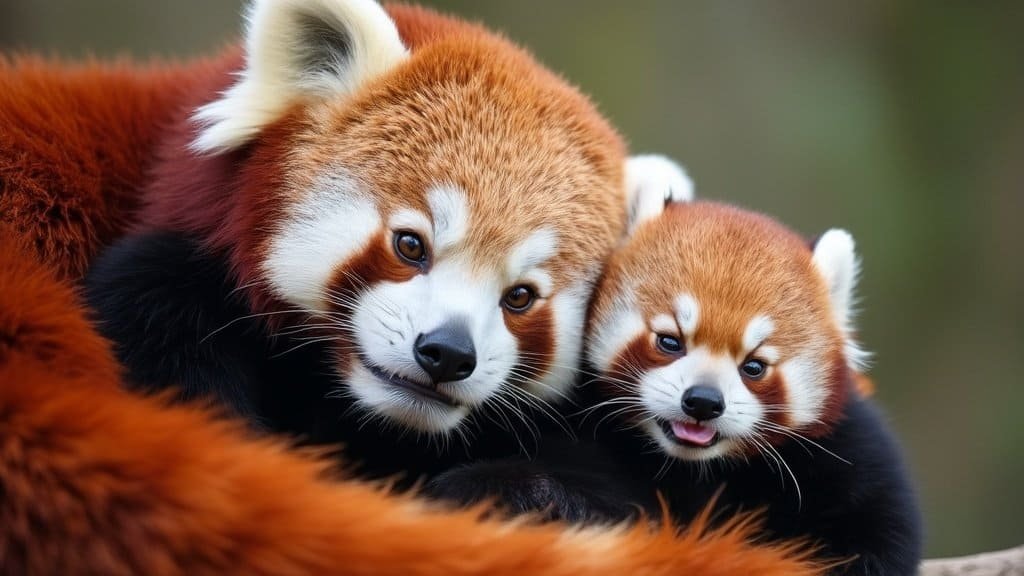
The survival of red panda cubs is directly impacted by habitat destruction, food scarcity, and climate change, making conservation efforts essential for protecting both mothers and their offspring. As wild red panda populations decline, conservationists are focusing on habitat restoration, captive breeding, and monitoring maternal care to improve cub survival rates and genetic diversity
By addressing the environmental challenges that affect litter size and cub survival, conservation programs play a key role in sustaining red panda populations. Protecting wild habitats, ensuring stable food sources, and supporting zoo-based breeding programs all contribute to higher reproductive success and a stronger future for the species
How Do Captive Breeding Programs Improve Cub Survival?
Captive breeding programs have become a vital tool in red panda conservation, helping to maintain healthy, genetically diverse populations while supporting research on maternal care and cub development. Zoos and conservation centers provide controlled environments where red panda pregnancies and births can be closely monitored, ensuring that both mothers and cubs receive the best possible care
One of the biggest advantages of captive breeding is the ability to track pregnancies using ultrasound technology and hormone analysis, allowing zookeepers to prepare appropriate nesting conditions before birth. Pregnant red pandas in captivity receive specialized diets rich in bamboo, fruits, and supplemental nutrients, ensuring they have enough energy to sustain pregnancy and lactation (Toronto Zoo)
Captive breeding programs have also helped researchers understand red panda maternal behaviors, including nesting habits, milk production, and cub rearing strategies. By studying how mothers care for cubs in protected environments, conservationists can apply this knowledge to wild populations, improving red panda management and habitat conservation strategies (National Zoo)
How Does Habitat Loss Impact Litter Size and Survival?
One of the greatest threats to red panda reproduction is habitat loss, which reduces food availability, nesting sites, and safe breeding areas. As forests are cleared for agriculture, logging, and human development, red pandas are forced into smaller, fragmented habitats, making it harder for females to find safe dens for birthing and raising cubs
Habitat loss also affects the number of cubs a mother can successfully raise, as degraded forests often have fewer bamboo resources to support pregnancy and lactation. Without sufficient food, mothers may experience higher cub mortality rates, as they struggle to produce enough milk or maintain the warmth and security needed for survival (Cape May County)
Climate change is another factor influencing litter size and cub survival, as rising temperatures can disrupt bamboo growth cycles. Red pandas rely on seasonal bamboo shoots and young leaves, which provide the highest nutritional value for pregnant and nursing mothers. If these food sources decline, females may produce smaller litters, or cubs may be born weaker and less likely to survive (National Zoo)
Conservation groups are working to restore red panda habitats by replanting bamboo forests, establishing protected reserves, and preventing illegal deforestation. These efforts ensure that wild red pandas have access to food and shelter, increasing the chances of successful reproduction and cub survival
What Conservation Programs Protect Red Panda Mothers and Cubs?
Several global conservation programs focus on protecting red panda mothers and their cubs, ensuring that reproduction remains stable despite environmental challenges. Organizations like the Red Panda Network, WWF, and various national parks in Nepal, India, and China are implementing initiatives to preserve red panda habitats, monitor breeding populations, and support rewilding efforts
One of the most important strategies in red panda conservation is community involvement. Many conservation programs work closely with local communities to promote sustainable farming, anti-poaching laws, and habitat restoration projects. By encouraging eco-tourism and responsible land use, these initiatives help reduce human impact on red panda breeding areas, allowing wild populations to grow naturally (National Zoo)
In addition to habitat protection, some programs focus on tracking red panda mothers and cubs in the wild, using GPS collars and camera traps to study nesting behaviors, cub survival rates, and environmental stressors. This data helps conservationists develop better protection strategies, ensuring that wild red pandas have the resources they need to raise healthy offspring
Captive breeding programs also contribute to long-term conservation efforts, with some zoos participating in reintroduction programs that return healthy, captive-born red pandas to protected reserves. These programs help boost wild populations while maintaining genetic diversity, making them an essential part of red panda conservation strategies (Toronto Zoo)
By combining habitat restoration, scientific monitoring, and captive breeding, conservationists are ensuring that red panda mothers and cubs have a better chance at survival in both wild and managed environments. For more information on conservation programs supporting red panda reproduction, visit the Red Panda Network’s page on habitat protection
